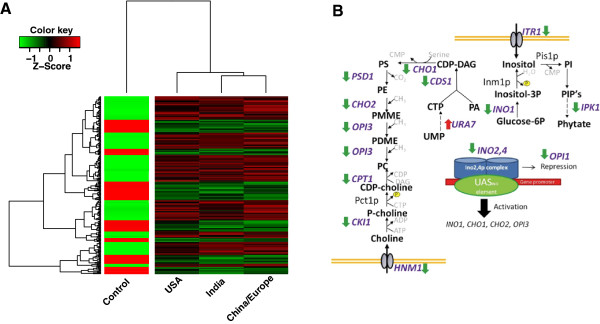Figure 7.

S. cerevisiae genes affected by treatment with E. arvense extracts. (A) A heat map of 221 genes that were significantly different (p < 0.05 after Bonferroni correction) in a contrast between control (n = 4) and all other E. arvense arrays (n = 12). Samples were averaged to yield 3 groups according to the clustering in Figure 6A. Genes were clustered to highlight similarities between the different samples on the one hand and differences relative to control on the other hand. The expression levels are scaled to the row mean. The color key relates the heat map colors to the standard score (z-score), i.e. the deviation from row mean in units of standard deviations. (B) Schematic representation of pathway analysis of exemplary S. cerevisiae genes regulated by treatment with E. arvense extracts. Green arrows label downregulated genes and red arrows upregulated genes. The pathway enzymes differentially expressed were IPK1, inositol polyphosphate kinase; INO1, inositol-1 phosphate synthase; CDS1, phosphatidate cytidyltransferase; CHO1, phosphatidylserine synthase; PSD1, phosphatidylserine decarboxylases; CHO2, phosphatidylethanolamine N-methyltransferase; OPI3, Phospholipid N-methyltransferase, CPT1, cholinephosphotransferase; CKI1, choline kinase and URA7, CTP synthase. The important metabolites throughout this pathway are phosphatidate (PA), uridine monophosphate (UMP), cytidine triphosphate (CTP), cytidine diphosphate - diacylglycerol (CDP-DAG), inositol, inositol-3 phosphate (inositol-3P), glucose-6 phosphate (glucose-6P), phosphatidylinositol (PI), phosphatidyl inositol phosphates (PIP’s), phytate, phosphatidylserine (PS), phosphatidylethanolamine (PE), phosphatidylmonomethyl-ethanolamine (PMME), phosphatidyldimethylethanolamine (PDME), phosphatidylcholine (PC), cytidine diphosphate -choline (CDP-choline), phosphate choline (P-choline) and choline. The important cell membrane and cell wall (yellow bars) transporters in this pathway are the myo-inositol (ITR1) and choline/ethanolamine transporters (HNM1). Inset; an inositol and choline mediated regulation of INO2, INO4 and OPI1 genes; the products of which form a heterodimer that binds to an upstream activating site to regulate the transcription of the INO1, CHO1, CHO2 and OPI3 genes [61].
